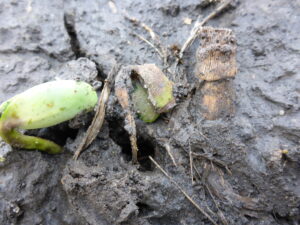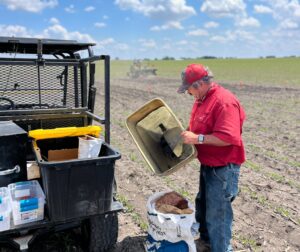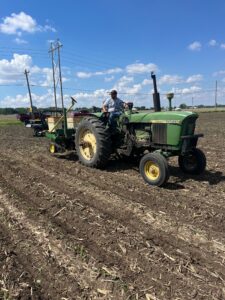
Scouting Report for Tazewell, Woodford, McLean, Livingston, and Champaign counties in Illinois
(Scroll down for NE and SD counties)
Reported by Robert “Bob” Starke, Ph.D.
What a great start for the 2025 soybean crop! With most farmers getting started planting right around Easter and wrapping up around Mother’s Day, it has been an excellent spring. While the season had a few cool days and nights, we have not had the frost risk after soybean planting as in the past few seasons. Most stands look pretty impressive, and with the temperature warming up – things are really starting to grow. Now is a great time to look for seedling diseases and to evaluate seed treatments. It’s best to look in low-lying areas or spots with poor drainage to find seedling diseases such as pythium, rhizoctonia, or fusarium. Individual plants may be infected with one or more pathogens. The most common early threat is Pythium, as shown below with the damping off and soft brown tissue. A more complete document to distinguish between Pythium, Rhizoctonia, and Fusarium is available here: Crop Protection Network. Sending off samples to a lab is the only way to positively confirm which pathogen(s) are responsible.
Sensor plots have been planted by Crop-Tech, and in the next few weeks, we will have all of the specialized detection equipment up and will be imaging plants twice a day for fungal detection.
Scouting Report for Cedar, Knox, Pierce counties in Nebraska and Yankton County in South Dakota
Reported by Tristan Mueller
Soybean planting progress is ahead of normal, with over 60% of the planned soybean acres planted. The entire state of Nebraska is entering the growing season in a drought (ranging from mild to severe). Most of the pathogens need wetter conditions during the season to drive disease, but some diseases, like charcoal rot, like hot, dry conditions. If it does turn wetter during the season, there is a potential for an outbreak of white mold since there were high levels in 2023, which left plenty of inoculum in the fields rotating back to soybeans again this year.
(Credit University of Nebraska-Lincoln, National Drought Mitigation Center)
All the Nebraska CropVoice plots are planted with our InnerSoy soybeans, and the specialized detection equipment will be deployed in the coming weeks. The detection equipment will take images twice a day and typically detect fungal infections well before you see them in your fields.




